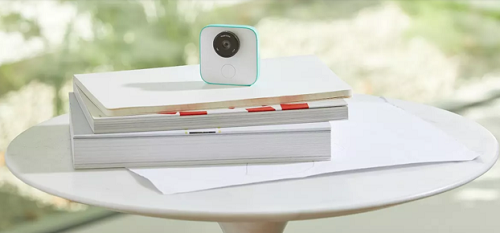
By Heather Hamilton, contributing writer
Google’s newest camera, Clips, uses machine learning and a specialized processor built by Movidius and owned by Intel to make sure you’re taking the best pictures. The Myriad 2, which is a visual processing unit, is made to execute machine-vision tasks such as object recognition. Movidius is also used in Google’s Project Tango and DJI autonomous drones, and Movidius says that it is the first always-on vision processor in the industry.
Basically, the tiny square camera is turned on in a room and, using AI, makes decisions on when to snap photographs based on its assessment of whether or not something interesting is happening in the room. It’s paired to your phone and learns over time, utilizing facial recognition to identify you, your family, and your pets. Eventually, it will ignore other faces in favor of photographing the people who are important to you.
All of the Clips camera’s processing takes place onboard the device, as opposed to cloud connections, which is Google’s way of guaranteeing privacy and longer battery life because there is no need to maintain a constant internet connection. You can only access the photos from the phone, so Google is not receiving your images.
Google appears to be marketing the camera primarily to parents and pet parents who may fear missing capturing important moments with their kids (and pets) that happen off-camera or to parents who would otherwise be taking the photographs. The camera can also be operated manually being that there is a shutter button.
Google has gone to great lengths to assure potential users that the camera is not creepy. It very much looks like a cute little camera, blinks when it’s recording so that there is no question, and doesn’t have a microphone. It doesn’t utilize the cloud, so your images don’t leave the device except to travel securely to your other device. Still, there are skeptics.
Long-time AI skeptic Elon Musk took to Twitter after the release, saying that Google’s intentions didn’t even seem innocent. Google declined to comment but is likely unhappy with Musk’s flippant comments, given his enormous following.
Google and Movidius entered into a partnership last year so that Google could improve image recognition on smartphones and other devices. Now, as the Clips camera launches, people are speculating about other sorts of collaborations that might be in the works. The Verge notes that on-device AI is the future — and says that specialized silicon is helping to deliver it.
The Clips camera offers a 130° lens on a 12-megapixel camera, 16 GB of storage, three hours of battery life when actively recording, and a few days of battery life on standby. It weighs 43 grams, has no mic, and works with Pixel, iPhone, and Samsung Galaxy S7 and S8, with additional phone support to come. The camera retails at $249 and will be available soon.
Advertisement
Learn more about Electronic Products Magazine





